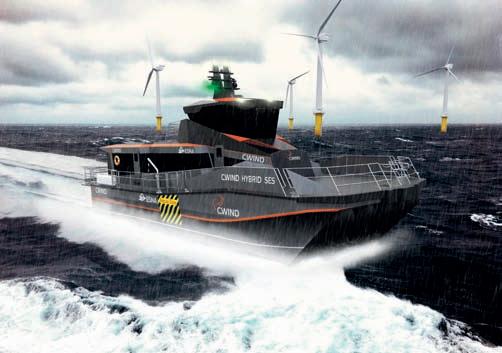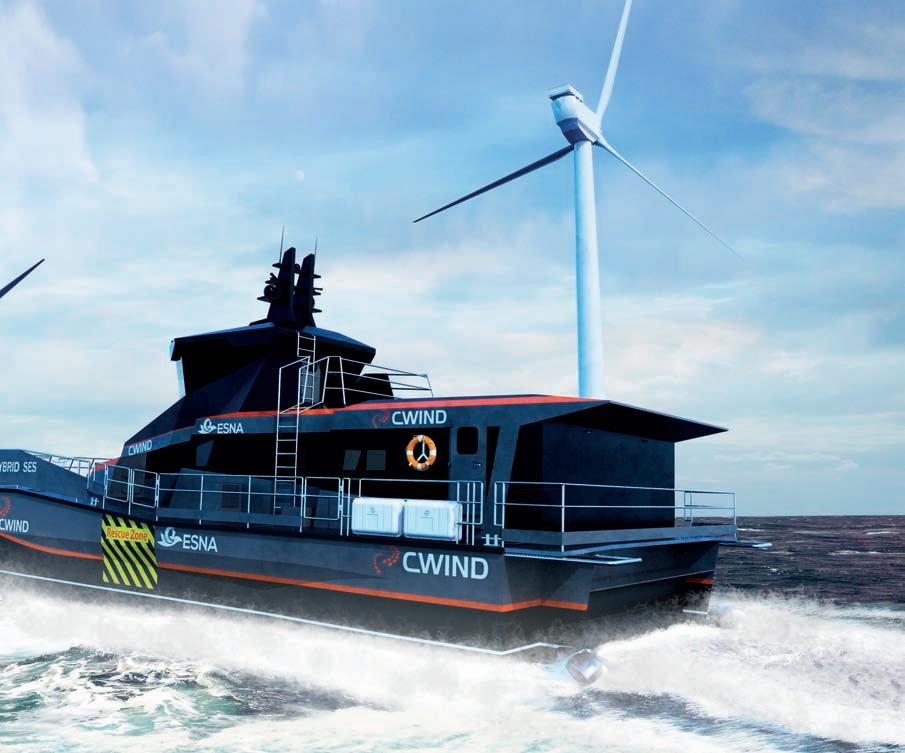
2 minute read
Surface effect vessel
FirST Hybrid SurFaCE EFFECT CTV FOr THE OFFSHOrE SECTOr
WigHT SHipyard CO HaS bEEN CONTraCTEd TO build THE FirST Hybrid SurFaCE EFFECT SHip (SES) dEdiCaTEd TO OFFSHOrE CrEW TraNSFErS. THE SES was designed specifically for the offshore sector, as it can handle 2m significant wave height during personnel transfer in heavy seas.
All imAges COurTESy OF WigHT SHipyard.
Upon completion in mid-2020, the CTV will commence operations from Vlissingen to the Borssele 1 & 2 windfarm.
Because of its motion-damped handling characteristics, the CTV will be able to outperform much larger vessels.
The surface effect CTV’s benefits are twofold. The vessel is able to transfer technicians in fairly heavy sea states, due to its motion-damped handling characteristics, while boasting lower fuel consumption and CO 2 emissions. The propulsion engine delivers sprint speed and extreme bollard push from its 1,600kW installed diesel engines, which can be battery boosted up to 1,878kW. The SES’s combination of electric infrastructure and battery availability allows for immediate power delivery, coupled with greater fuel efficiency. Significant fuel savings will be achieved through balancing engine and inefficient low engine power running hours, with battery drive modes including windfarm standby and low speed/harbour operations. This can lead to an engine operating hour reduction of 50% during windfarm battery standby. digitalisation will be built into the hybrid SES so that machine learning begins from the day it sets sail, allowing the crew to make operational decisions and judgements based on both data collected over time and their own experience. Catamaran characteristics The CTV was ordered by CWind, who have built a reputation in the fast ferry arena and commercial marine sector. The concept was developed by CWind in partnership with ESNa, a ship design company based in Kristiansand, Norway, which specialises in commercially competitive vessels with surface effect technology to deliver significant carbon reductions. The hybrid SES consists of two catamaran hulls, with the area between the hulls closed by flexible reinforced rubber fingers in the bow and an inflated rubber bag in the

stern. Centrifugal fans blow air into this enclosed space, providing an air cushion that supports up to 80% of the vessel weight. The remaining 20% is supported by hull buoyancy, allowing for higher vessel speed because of the significant decrease in hull resistance. The air cushion is also used to compensate for wave induced motions. Because of this she allows for safe turbine boat landing access in higher wave heights than conventional crew boats of similar size. An added benefit is that the air cushion acts as a large shock absorber, improving seakeeping and reducing seasickness. The overall design and build, with 24 passenger capacity, will pay particular attention to technician and crew health, safety and comfort, thus delivering the workforce in the best possible work-ready condition.
Borssele windfarms CWind has a long-term charter contract agreement for the new SES with Ørsted, who operate the Borssele 1&2 offshore windfarm. The agreement starts in mid-2020 and covers an initial three-year firm charter with options available for a further two years.
The surface effect CTV will enable Ørsted to deliver and service windfarms efficiently through reduced transit times, as well as support Ørsted’s green energy ambition. After completion, which is scheduled by the end of this summer, the vessel will commence operations from the Dutch port of Vlissingen to Borssele 1&2.
i. wightshipyard.com










